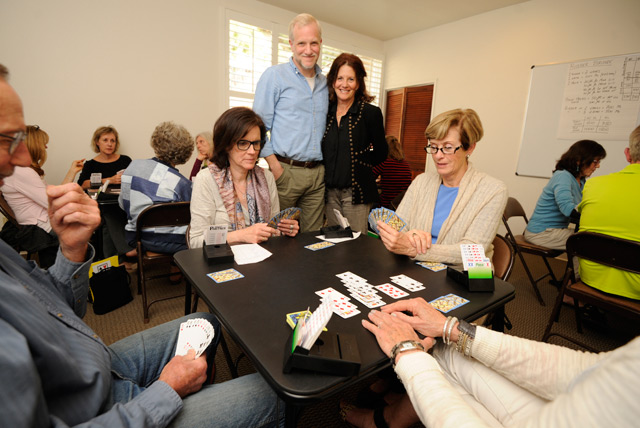Bridge School’s Benefits
Carole Bennett and Alain Cardinal Teach Classic and Competitive Game on De la Vina Street

The memory is seared in my mind: A close cousin and I learning to play bridge one afternoon with my grandparents in their kitchen. We were probably around 18 or so years old, and Grandpa was letting us puff from one of his old wooden pipes, so we shared lots of laughs through the yellow haze of tobacco smoke. Grandma died a few years later, and Grandpa is gone now, too, but I know they found magic in that moment, as two distinct generations — theirs of World War II and big bands, ours of Nintendo and hip-hop — bonded over the classic card game in which two-person teams bid and then compete for the most tricks.
So when the Pacific Bridge School opened in Santa Barbara a couple of months ago, this memory flared, and I decided to attend some classes to see how much I actually remembered from that long-ago afternoon. Set in a simple, low-slung building across from Jedlicka’s on De la Vina Street, the school was founded by Carole Bennett, who’s been teaching bridge classes at SBCC for years, and Alain Cardinal, a French-Canadian retired IT expert who’s been playing since he was 15 years old.
“It’s like a little bridge country club,” explained Bennett of the school’s various offerings, from beginning to intermediate classes and supervised play days to private lessons and even monthly backyard barbecues. “We’ve made it so that Beginning students will move to Beyond Basics and then Beyond goes to Intermediate. We’re trying to build a career for them.”
Within a few minutes of my first class, I realized that what I’d been playing with my grandparents was the much more rudimentary and social game known as rubber bridge (also called party bridge). What the Pacific Bridge School teaches is duplicate bridge. This more competitive version uses special decks that are prearranged in a certain order so that the element of chance is removed and only bridge-playing skill is on display.
“It’s very intense and very difficult, but it’s also very stimulating,” said Bennett, who believes playing bridge is a good way for the aging population to keep their minds sharp. But she also hopes more younger people start taking up bridge, too. “We’re trying to make it an intergenerational kind of hobby,” explained Bennett, who thinks it takes about six months of steady studying and playing to really get the hang of it. “It’s exciting when you see that light go on and a student says, ‘Yes, I’ve got it,’” she said.
I didn’t quite get there in the couple of courses I attended. Bridge truly has its own language, and the scribblings Bennett and Cardinal throw up on the whiteboard look like advanced calculus equations. I also discovered that they are teaching certain types of strategies, but that there isn’t one right way to play. “This is one of thousands of conventions,” said Cardinal during one lesson. “There are multiple ways to play bridge, and there is no best way.”
After each lesson, the students get to play some hands, and that’s when I started to rekindle that thrill I’d first found with my grandparents 20 years ago. I don’t have enough free time on my hands to dive into a bridge career quite yet, but it’s certainly a game that I look forward to playing when I do. And maybe one day I’ll play with my own grandkids, too, most likely minus the pipe smoke.
4•1•1
The Pacific Bridge School (2600 De la Vina St., Ste. E) is hosting Learn Bridge in a Day classes on Saturday-Sunday, May 14-15, at 11 a.m.-5 p.m., for $65. See pacificbridgeschool.com or call (805) 453-9701.



